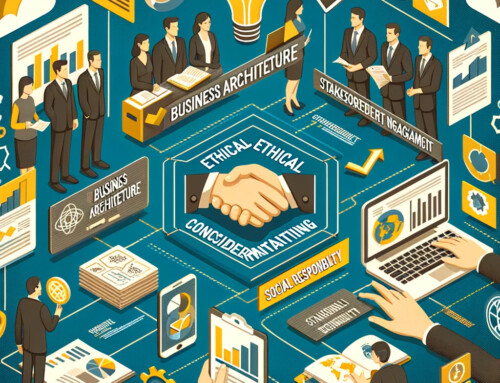
Integrating Enterprise Architecture with Agile Methodologies.
Integrating Enterprise Architecture (EA) with Agile methodologies represents a paradigm shift in how organizations approach technology strategy and software development. Let’s delve into the methodologies, challenges, and pratical applications of merging EA with Agile practices, aiming to highlight how this integration can significantly enhance organizational agility, speed to market, and strategic alignment.
Agile EA Integration
In the fast-paced digital economy, businesses face the dual challenge of staying agile to meet immediate market demands while aligning these efforts with long-term strategic goals. Traditional EA practices, designed to ensure that IT aligns with business strategy, often seem at odds with the rapid, iterative nature of Agile development methodologies. However, when harmoniously integrated, EA and Agile can provide a robust framework for achieving both immediate and strategic objectives, offering a blueprint for organizations to navigate the complexities of digital transformation effectively.
The Imperative for Agile in Enterprise Architecture
The push towards digital transformation has necessitated a more flexible approach to EA. Agile methodologies, with their focus on adaptability, customer feedback, and iterative development, offer key advantages in this context. The integration of Agile practices into EA enables organizations to respond to changes swiftly without losing sight of their architectural principles and long-term strategic vision. This synergy between Agile and EA ensures that businesses can innovate rapidly while maintaining coherence and alignment with overarching business objectives.
Strategies for Harmonizing EA and Agile
Adaptive EA Frameworks: Modernizing traditional EA frameworks to incorporate Agile principles is crucial. This involves revising the governance structures, processes, and tools to support more iterative and flexible approaches to architecture planning and implementation. For instance, incorporating sprints and Agile ceremonies into the EA planning process allows for more responsive and incremental architecture development.
Agile Governance within EA: Establishing governance models that bridge the strategic oversight provided by EA with the flexibility of Agile execution is essential. This includes creating clear guidelines for decision-making, roles, and responsibilities that encourage collaboration and ensure that Agile projects align with the enterprise’s architectural standards and strategic goals.
Fostering a Collaborative Culture: The success of integrating EA with Agile methodologies heavily relies on nurturing a culture of collaboration and open communication. This involves breaking down silos between architects, developers, and business stakeholders to encourage a holistic approach to project planning and execution. Regular cross-functional meetings, shared objectives, and integrated teams are key to fostering this collaborative environment.
Success Stories
Financial Services Agile EA Transformation
A multinational financial services corporation faced challenges in aligning its rapid software development cycles with the broader strategic goals set by its EA. By embedding Agile principles within its EA processes, the organization could streamline project delivery and enhance collaboration between its development teams and strategic planners.
- Solution: The corporation adopted a modified version of the TOGAF framework that incorporated Agile methodologies at its core. This included setting up cross-functional teams consisting of enterprise architects, developers, and business analysts to work on projects in sprints, aligning each deliverable with the strategic objectives identified in the EA.
- Outcome: The initiative led to a 30% improvement in project delivery times and a significant increase in the alignment of IT projects with strategic business outcomes, demonstrating the value of integrating Agile practices within EA frameworks.
Healthcare Digital Transformation through Agile EA
A leading healthcare provider embarked on a digital transformation journey to improve patient care and operational efficiency. The challenge was to ensure that the rapid deployment of new digital health solutions was in line with the organization’s long-term strategic goals and complied with stringent healthcare regulations.
- Solution: The healthcare organization implemented an Agile EA approach, which involved iterative development and continuous feedback loops within the planning and execution of its digital health initiatives. This approach was supported by an Agile governance model that emphasized collaboration, rapid iteration, and strategic alignment.
- Outcome: The Agile EA integration enabled the healthcare provider to quickly adapt to changing patient needs and regulatory requirements, resulting in enhanced patient services and improved compliance. The organization reported a notable increase in patient satisfaction and a reduction in time-to-market for new digital services.
Navigating the Challenges of Agile EA Integration
Integrating EA with Agile methodologies is not without its challenges. These include maintaining the balance between flexibility and strategic alignment, ensuring architectural integrity amidst rapid iterations, and fostering a culture that embraces both Agile and EA principles. Successful navigation of these challenges requires clear communication, strong leadership, and a commitment to continuous learning and adaptation.
The integration of Enterprise Architecture with Agile methodologies offers a strategic advantage in the digital age, enabling organizations to remain agile and innovative while ensuring alignment with long-term strategic objectives. By adopting a flexible approach to EA that incorporates Agile principles, organizations can enhance their responsiveness to market changes, improve collaboration across teams, and drive more effective and strategic IT investments. As the digital landscape continues to evolve, the fusion of EA and Agile methodologies will undoubtedly play a pivotal role in shaping the future of business strategy and technology management.


